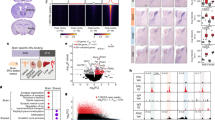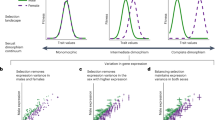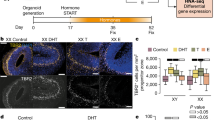Abstract
In the twentieth century, the dominant model of sexual differentiation stated that genetic sex (XX versus XY) causes differentiation of the gonads, which then secrete gonadal hormones that act directly on tissues to induce sex differences in function. This serial model of sexual differentiation was simple, unifying and seductive. Recent evidence, however, indicates that the linear model is incorrect and that sex differences arise in response to diverse sex-specific signals originating from inherent differences in the genome and involve cellular mechanisms that are specific to individual tissues or brain regions. Moreover, sex-specific effects of the environment reciprocally affect biology, sometimes profoundly, and must therefore be integrated into a realistic model of sexual differentiation. A more appropriate model is a parallel-interactive model that encompasses the roles of multiple molecular signals and pathways that differentiate males and females, including synergistic and compensatory interactions among pathways and an important role for the environment.
This is a preview of subscription content, access via your institution
Access options
Subscribe to this journal
Receive 12 print issues and online access
$209.00 per year
only $17.42 per issue
Buy this article
- Purchase on Springer Link
- Instant access to full article PDF
Prices may be subject to local taxes which are calculated during checkout




Similar content being viewed by others
References
Cahill, L. Why sex matters for neuroscience. Nat. Rev. Neurosci. 7, 477–484 (2006).
Mogil, J.S. & Chanda, M.L. The case for the inclusion of female subjects in basic science studies of pain. Pain 117, 1–5 (2005).
Voskuhl, R. Sex differences in autoimmune diseases. Biol. Sex Differ. 2, 1 (2011).
Swaab, D.F. & Hofman, M.A. Sexual differentiation of the human hypothalamus in relation to gender and sexual orientation. Trends Neurosci. 18, 264–270 (1995).
McCarthy, M., De Vries, G. & Forger, N. in Hormones, Brain and Behavior, Vol. 3 (eds. Pfaff, D.W., Arnold, A.P., Etgen, A.M., Fahrbach, S.E. & Rubin, R.T.) Ch. 17, 1707–1744 (Academic Press, 2009).
Amateau, S.K. & McCarthy, M.M. Induction of PGE(2) by estradiol mediates developmental masculinization of sex behavior. Nat. Neurosci. 7, 643–650 (2004).
Schwarz, J.M., Liang, S.-L., Thompson, S.M. & McCarthy, M.M. Estradiol induces hypothalamic dendritic spines by enhancing glutamate release: a mechanism for organizational sex differences. Neuron 58, 584–598 (2008).
Park, J.H., Bonthius, P.J., Tsai, H.W., Bekiranov, S. & Rissman, E.F. Amyloid beta precursor protein regulates male sexual behavior. J. Neurosci. 30, 9967–9972 (2010).
Beery, A.K. & Zucker, I. Sex bias in neuroscience and biomedical research. Neurosci. Biobehav. Rev. 35, 565–572 (2011).
Jazin, E. & Cahill, L. Sex differences in molecular neuroscience: from fruit flies to humans. Nat. Rev. Neurosci. 11, 9–17 (2010).
De Vries, G.J. Minireview: Sex differences in adult and developing brains: compensation, compensation, compensation. Endocrinology 145, 1063–1068 (2004).
Arnold, A.P. & Chen, X. What does the “four core genotypes” mouse model tell us about sex differences in the brain and other tissues? Front. Neuroendocrinol. 30, 1–9 (2009).
Szyf, M., McGowan, P. & Meaney, M.J. The social environment and the epigenome. Environ. Mol. Mutagen. 49, 46–60 (2008).
Phoenix, C.H., Goy, R.W., Gerall, A.A. & Young, W.C. Organizing action of prenatally administered testosterone proprionate on the tissues mediating mating behavior in the female guinea pig. Endocrinology 65, 369–382 (1959).
Arnold, A.P. The organizational-activational hypothesis as the foundation for a unified theory of sexual differentiation of all mammalian tissues. Horm. Behav. 55, 570–578 (2009).
Sisk, C.L. & Zehr, J.L. Pubertal hormones organize the adolescent brain and behavior. Front. Neuroendocrinol. 26, 163–174 (2005).
Zhao, D. et al. Somatic sex identity is cell autonomous in the chicken. Nature 464, 237–242 (2010).
Goodfellow, P.N. & Lovell-Badge, R. SRY and sex determination in mammals. Annu. Rev. Genet. 27, 71–92 (1993).
Dewing, P. et al. Direct regulation of adult brain function by the male-specific factor SRY. Curr. Biol. 16, 415–420 (2006).
Becker, J.B., Molenda, H. & Hummer, D.L. Gender differences in the behavioral responses to cocaine and amphetamine. Implications for mechanisms mediating gender differences in drug abuse. Ann. NY Acad. Sci. 937, 172–187 (2001).
McCarthy, M.M. & Konkle, A.T. When is a sex difference not a sex difference? Front. Neuroendocrinol. 26, 85–102 (2005).
Chang, S.C., Tucker, T., Thorogood, N.P. & Brown, C.J. Mechanisms of X-chromosome inactivation. Front. Biosci. 11, 852–866 (2006).
Migeon, B.R. Females are Mosaic: X Inactivation and Sex Differences in Disease (Oxford University Press, 2007).
Arnold, A.P. Sex chromosomes and brain gender. Nat. Rev. Neurosci. 5, 701–708 (2004).
Arnold, A.P. Mouse models for evaluating sex chromosome effects that cause sex differences in non-gonadal tissues. J. Neuroendocrinol. 21, 377–386 (2009).
Majdic, G. & Tobet, S. Cooperation of sex chromosomal genes and endocrine influences for hypothalamic sexual differentiation. Front. Neuroendocrinol. published online, doi:10.1016/j.yfrne.2011.02.009 (19 February 2011).10.1016/j.yfrne.2011.02.009
De Vries, G.J. et al. A model system for study of sex chromosome effects on sexually dimorphic neural and behavioral traits. J. Neurosci. 22, 9005–9014 (2002).
Arnold, A.P. et al. Minireview: Sex chromosomes and brain sexual differentiation. Endocrinology 145, 1057–1062 (2004).
Gatewood, J.D. et al. Sex chromosome complement and gonadal sex influence aggressive and parental behaviors in mice. J. Neurosci. 26, 2335–2342 (2006).
Gioiosa, L., Chen, X., Watkins, R., Umeda, E.A. & Arnold, A.P. Sex chromosome complement affects nociception and analgesia in newborn mice. J. Pain 9, 962–969 (2008).
Gioiosa, L. et al. Sex chromosome complement affects nociception in tests of acute and chronic exposure to morphine in mice. Horm. Behav. 53, 124–130 (2008).
Quinn, J.J., Hitchcott, P.K., Umeda, E.A., Arnold, A.P. & Taylor, J.R. Sex chromosome complement regulates habit formation. Nat. Neurosci. 10, 1398–1400 (2007).
Barker, J.M., Torregrossa, M.M., Arnold, A.P. & Taylor, J.R. Dissociation of genetic and hormonal influences on sex differences in alcoholism-related behaviors. J. Neurosci. 30, 9140–9144 (2010).
Chen, X. et al. Sex difference in neural tube defects in p53-null mice is caused by differences in the complement of X not Y genes. Dev. Neurobiol. 68, 265–273 (2008).
Smith-Bouvier, D.L. et al. A role for sex chromosome complement in the female bias in autoimmune disease. J. Exp. Med. 205, 1099–1108 (2008).
Cox, K.H. & Rissman, E.F. Sex differences in juvenile mouse social behavior are influenced by sex chromosomes and social context. Genes Brain Behav. published online, doi:10.1111/j.1601-183X.2011.00688.x (17 March 2011).10.1111/j.1601-183X.2011.00688.x
McPhie-Lalmansingh, A.A., Tejada, L.D., Weaver, J.L. & Rissman, E.F. Sex chromosome complement affects social interactions in mice. Horm. Behav. 54, 565–570 (2008).
Chen, X., Grisham, W. & Arnold, A.P. X chromosome number causes sex differences in gene expression in adult mouse striatum. Eur. J. Neurosci. 29, 768–776 (2009).
van Nas, A. et al. Elucidating the role of gonadal hormones in sexually dimorphic gene coexpression networks. Endocrinology 150, 1235–1249 (2009).
Abel, J.M., Witt, D.M. & Rissman, E.F. Sex differences in the cerebellum and frontal cortex: roles of estrogen receptor alpha and sex chromosome genes. Neuroendocrinology published online, doi:10.1159/000324402 (16 February 2011).10.1159/000324402
Davies, W., Isles, A.R., Burgoyne, P.S. & Wilkinson, L.S. X-linked imprinting: effects on brain and behavior. Bioessays 28, 35–44 (2006).
Gregg, C., Zhang, J., Butler, J.E., Haig, D. & Dulac, C. Sex-specific parent-of-origin allelic expression in the mouse brain. Science 329, 682–685 (2010).
McCarthy, M.M. Estradiol and the developing brain. Physiol. Rev. 88, 91–124 (2008).
Ogawa, S. et al. Roles of estrogen receptor-α gene expression in reproduction-related behaviors in female mice. Endocrinology 139, 5070–5081 (1998).
Ogawa, S. et al. Abolition of male sexual behaviors in mice lacking estrogen receptors alpha and beta (alpha beta ERKO). Proc. Natl. Acad. Sci. USA 97, 14737–14741 (2000).
Kudwa, A.E., Bodo, C., Gustafsson, J.A. & Rissman, E.F. A previously uncharacterized role for estrogen receptor beta: defeminization of male brain and behavior. Proc. Natl. Acad. Sci. USA 102, 4608–4612 (2005).
Honda, S., Harada, N., Ito, S., Takagi, Y. & Maeda, S. Disruption of sexual behavior in male aromatase-deficient mice lacking exons 1 and 2 of the cyp19 gene. Biochem. Biophys. Res. Commun. 252, 445–449 (1998).
Bakker, J., Honda, S., Harada, N. & Balthazart, J. The aromatase knockout (ArKO) mouse provides new evidence that estrogens are required for the development of the female brain. Ann. NY Acad. Sci. 1007, 251–262 (2003).
Bakker, J. & Brock, O. Early oestrogens in shaping reproductive networks: evidence for a potential organisational role of oestradiol in female brain development. J. Neuroendocrinol. 22, 728–735 (2010).
Juntti, S.A., Coats, J.K. & Shah, N.M. A genetic approach to dissect sexually dimorphic behaviors. Horm. Behav. 53, 627–637 (2008).
Juntti, S.A. et al. The androgen receptor governs the execution, but not programming, of male sexual and territorial behaviors. Neuron 66, 260–272 (2010).
Matsumoto, A. Sexual Differentiation of the Brain (CRC Press, 2000).
Morris, J.A., Jordan, C.L. & Breedlove, S.M. Sexual differentiation of the vertebrate nervous system. Nat. Neurosci. 7, 1034–1039 (2004).
Forger, N.G. et al. Deletion of Bax eliminates sex differences in the mouse forebrain. Proc. Natl. Acad. Sci. USA 101, 13666–13671 (2004).
Waters, E.M. & Simerly, R.B. Estrogen induces caspase-dependent cell death during hypothalamic development. J. Neurosci. 29, 9714–9718 (2009).
Krishnan, S., Intlekofer, K.A., Aggison, L.K. & Petersen, S.L. Central role of TRAF-interacting protein in a new model of brain sexual differentiation. Proc. Natl. Acad. Sci. USA 106, 16692–16697 (2009).
Simerly, R.B. Wired for reproduction: organization and development of sexually dimorphic circuits in the mammalian forebrain. Annu. Rev. Neurosci. 25, 507–536 (2002).
Zhang, J.-M., Konkle, A.T.M., Zup, S.L. & McCarthy, M.M. Impact of sex and hormones on new cells in the developing rat hippocampus: a novel source of sex dimorphism? Eur. J. Neurosci. 27, 791–800 (2008).
Bowers, J., Waddell, J. & McCarthy, M. A developmental sex difference in hippocampal neurogenesis is mediated by endogenous estradiol. Biol. Sex Differ. 1, 8 (2010).
Isgor, C. & Sengelaub, D.R. Prenatal gonadal steroids affect adult spatial behavior, CA1 and CA3 pyramidal cell morphology in rats. Horm. Behav. 34, 183–198 (1998).
Krebs-Kraft, D.L., Hill, M.N., Hillard, C.J. & McCarthy, M.M. Sex difference in cell proliferation in developing rat amygdala mediated by endocannabinoids has implications for social behavior. Proc. Natl. Acad. Sci. USA 107, 20535–20540 (2010).
de Vries, G.J. et al. Sexual differentiation of vasopressin innervation of the brain: cell death versus phenotypic differentiation. Endocrinology 149, 4632–4637 (2008).
Mong, J.A., Glaser, E. & McCarthy, M.M. Gonadal steroids promote glial differentiation and alter neuronal morphology in the developing hypothalamus in a regionally specific manner. J. Neurosci. 19, 1464–1472 (1999).
Todd, B.J., Schwarz, J.M., Mong, J.A. & McCarthy, M.M. Glutamate AMPA/kainate receptors, not GABAA receptors, mediate estradiol-induced sex differences in the hypothalamus. Dev. Neurobiol. 67, 304–315 (2007).
Wright, C.L., Burks, S.R. & McCarthy, M.M. Identification of prostaglandin E2 receptors mediating perinatal masculinization of adult sex behavior and neuroanatomical correlates. Dev. Neurobiol. 68, 1406–1419 (2008).
Wright, C.L. & McCarthy, M.M. Prostaglandin E2-induced masculinization of brain and behavior requires protein kinase A, AMPA/kainate and metabotropic glutamate receptor signaling. J. Neurosci. 29, 13274–13282 (2009).
Mong, J.A., Nunez, J.L. & McCarthy, M.M. GABA mediates steroid-induced astrocyte differentiation in the neonatal rat hypothalamus. J. Neuroendocrinol. 14, 45–55 (2002).
Schwarz, J.M. & McCarthy, M.M. The role of neonatal NMDA receptor activation in defeminization and masculinization of sex behavior in the rat. Horm. Behav. 54, 662–668 (2008).
Herrmann, K. & Arnold, A.P. Lesions of HVc block the developmental masculinizing effects of estradiol in the female zebra finch song system. J. Neurobiol. 22, 29–39 (1991).
Grisham, W., Mathews, G.A. & Arnold, A.P. Local intracerebral implants of estrogen masculinize some aspects of the zebra finch song system. J. Neurobiol. 25, 185–196 (1994).
Beato, M. Gene regulation by steroid hormones. Cell 56, 335–344 (1989).
Beato, M. & Klug, J. Steroid hormone receptors: an update. Hum. Reprod. Update 6, 225–236 (2000).
Woolley, C.S. Acute effects of estrogen on neuronal physiology. Annu. Rev. Pharmacol. Toxicol. 47, 657–680 (2007).
Balthazart, J. & Ball, G.F. Is brain estradiol a hormone or a neurotransmitter? Trends Neurosci. 29, 241–249 (2006).
Remage-Healey, L., Maidment, N.T. & Schlinger, B.A. Forebrain steroid levels fluctuate rapidly during social interactions. Nat. Neurosci. 11, 1327–1334 (2008).
Petrosino, S. & Di Marzo, V. FAAH and MAGL inhibitors: therapeutic opportunities from regulating endocannabinoid levels. Curr. Opin. Investig. Drugs 11, 51–62 (2010).
Hill, M.N. et al. Functional interactions between stress and the endocannabinoid system: from synaptic signaling to behavioral output. J. Neurosci. 30, 14980–14986 (2010).
Micevych, P., Kuo, J. & Christensen, A. Physiology of membrane oestrogen receptor signaling in reproduction. J. Neuroendocrinol. 21, 249–256 (2009).
Garcia-Segura, L.M., Lorenz, B. & DonCarlos, L.L. The role of glia in the hypothalamus: implications for gonadal steroid feedback and reproductive neuroendocrine output. Reproduction 135, 419–429 (2008).
London, S.E., Remage-Healey, L. & Schlinger, B.A. Neurosteroid production in the songbird brain: a re-evaluation of core principles. Front. Neuroendocrinol. 30, 302–314 (2009).
Fausto-Sterling, A. Sexing the Body: Gender Politics and the Construction of Sexuality (Basic Books, 2000).
Frome, P.M. & Eccles, J.S. Parents' influence on children's achievement-related perceptions. J. Pers. Soc. Psychol. 74, 435–452 (1998).
Lippa, R.A. Sex differences in personality traits and gender-related occupational preferences across 53 nations: testing evolutionary and social-environmental theories. Arch. Sex. Behav. 39, 619–636 (2010).
Champagne, F.A. Epigenetic mechanisms and the transgernational effects of maternal care. Front. Neuroendocrinol. 29, 386–397 (2008).
Moore, C.L. Maternal contributions to the development of masculine sexual behavior in laboratory rats. Dev. Psychobiol. 17, 347–356 (1984).
Lenz, K.M. & Sengelaub, D.R. Maternal licking influences dendritic development of motoneurons in a sexually dimorphic neuromuscular system. Brain Res. 1092, 87–99 (2006).
Kurian, J.R., Olesen, K.M. & Auger, A.P. Sex differences in epigenetic regulation of the estrogen receptor-alpha promoter within the developing preoptic area. Endocrinology 151, 2297–2305 (2010).
Westberry, J.M., Trout, A.L. & Wilson, M.E. Epigenetic regulation of estrogen receptor alpha gene expression in the mouse cortex during early postnatal development. Endocrinology 151, 731–740 (2010).
Schwarz, J.M., Nugent, B.M. & McCarthy, M.M. Developmental and hormone-induced epigenetic changes to estrogen and progesterone receptor genes in brain are dynamic across the life span. Endocrinology 151, 4871–4881 (2010).
Tsai, H.W., Grant, P.A. & Rissman, E.F. Sex differences in histone modifications in the neonatal mouse brain. Epigenetics 4, 47–53 (2009).
Murray, E.K., Hien, A., de Vries, G.J. & Forger, N.G. Epigenetic control of sexual differentiation of the bed nucleus of the stria terminalis. Endocrinology 150, 4241–4247 (2009).
McCarthy, M.M. et al. The epigenetics of sex differences in the brain. J. Neurosci. 29, 12815–12823 (2009).
Acknowledgements
Work on this manuscript was supported by grants MH52716 and NS050525 to M.M.M. and grants NS043196 and DC000217 to A.P.A.
Author information
Authors and Affiliations
Corresponding author
Ethics declarations
Competing interests
The authors declare no competing financial interests.
Rights and permissions
About this article
Cite this article
McCarthy, M., Arnold, A. Reframing sexual differentiation of the brain. Nat Neurosci 14, 677–683 (2011). https://doi.org/10.1038/nn.2834
Published:
Issue Date:
DOI: https://doi.org/10.1038/nn.2834
This article is cited by
-
Changes in the volumes and asymmetry of subcortical structures in healthy individuals according to gender
Anatomical Science International (2023)
-
Advanced structural brain aging in preclinical autosomal dominant Alzheimer disease
Molecular Neurodegeneration (2023)
-
Postnatal developmental trajectory of sex-biased gene expression in the mouse pituitary gland
Biology of Sex Differences (2022)
-
A sex difference in mouse dopaminergic projections from the midbrain to basolateral amygdala
Biology of Sex Differences (2022)
-
Sex-specific multi-level 3D genome dynamics in the mouse brain
Nature Communications (2022)



